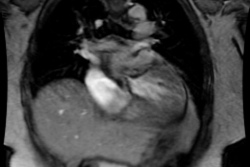Takahashi N, Bae KT.
PURPOSE: To assess the interscan variability of coronary artery calcium as measured with different tube currents and quantification methods in prospective electrocardiography (ECG)-gated multi-detector row CT. MATERIALS AND METHODS: Thirty-three subjects who were asymptomatic for coronary heart disease underwent prospective ECG-gated, subsecond multi-detector row CT of the heart. Each subject underwent two consecutive CT examinations, the first with a dose of either 40 mAs (n = 18) or 80 mAs (n = 15) and the second with a dose of 150 mAs. Calcium volume and calcium score were calculated. Pearson correlation coefficient was computed between the calcium scores of high- and low-dose examinations. Interscan variability in these measurements (ie, the absolute percentage difference) was compared between the examinations with 40-150 mAs and those with 80-150 mAs by using an independent sample t test. In addition, the interscan variabilities of calcium scores between vessels were evaluated with repeated measures of analysis of variance. The interscan variabilities between calcium score and volume measurement were also compared with paired t tests. RESULTS: Twenty-seven of 33 subjects had coronary artery calcium deposits on both CT scans. Five subjects had no calcium deposit on either scan. One subject had calcium deposits on only one scan. The total calcium score between the high- and low-dose scans was highly correlated (r = 0.98) and was not significantly different (P =.58). The interscan variability of calcium score showed no significant difference with respect to subject (P =.25) or vessel (P =.84). The interscan variability of the calcium volume measurement was significantly lower than that of the calcium score with respect to both the subject (P <.01) and the vessel (P <.01). CONCLUSION: A dose of 40 mAs appears adequate for quantifying coronary artery calcium at multi-detector row CT. Interscan variability of multi-detector row CT is substantially reduced by using the calcium volume method.





